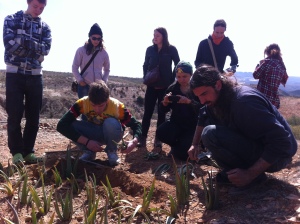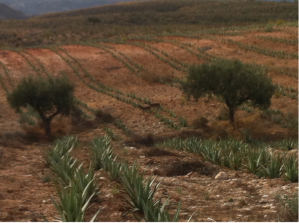Communication and Education, Sunseed News
 Every week at Sunseed, a seminar is held by either one of our staff or volunteers. It is an opportunity to share and communicate something that you feel that is of interest or passionate about, and also reaffirms Sunseed´s ethos of being a place of education, sharing knowledge, having debate and discussion about the world that we live in. Many volunteers give feedback that the seminars are one of the highlights of their week here. It is a great chance to learn something new and connect to other people on the project and what they are specialised in or fascinated about. Examples of seminar topics vary and have included: different country profiles, menstrual activism, facilitation techniques, bats, veganism, the history of Sunseed, biomass stoves, natural toothpaste and conflcit resolution to name but a few!
So far in 2014, we have enjoyed seminars on:
The Permaculture of Money – a look at the dysfunctions of the conventional money system using permaculture values – people care, earth care and fair shares – and some key permaculture principles applied to the money system. Followed by a discussion of monetary reform campaigns and the burgeoning network of alternative money systems – LETSystems, Gift economies, Timebanking, P2P finance, virtual currencies and microfinance.
Digital consumer consciousness – an awareness-raising seminar focused on the Internet and user profiles recorded by major Internet companies and search engines. Alternative options for increased privacy/anonymity were also discussed.
The Mindful Meditation techniques and ideas championed by Jon Kabat Zinn
Belief Systems and Disgust: Why do we think they way we do sometimes? And how to challenge or be aware of it, especially when it comes to using compost toilets!
Every week at Sunseed, a seminar is held by either one of our staff or volunteers. It is an opportunity to share and communicate something that you feel that is of interest or passionate about, and also reaffirms Sunseed´s ethos of being a place of education, sharing knowledge, having debate and discussion about the world that we live in. Many volunteers give feedback that the seminars are one of the highlights of their week here. It is a great chance to learn something new and connect to other people on the project and what they are specialised in or fascinated about. Examples of seminar topics vary and have included: different country profiles, menstrual activism, facilitation techniques, bats, veganism, the history of Sunseed, biomass stoves, natural toothpaste and conflcit resolution to name but a few!
So far in 2014, we have enjoyed seminars on:
The Permaculture of Money – a look at the dysfunctions of the conventional money system using permaculture values – people care, earth care and fair shares – and some key permaculture principles applied to the money system. Followed by a discussion of monetary reform campaigns and the burgeoning network of alternative money systems – LETSystems, Gift economies, Timebanking, P2P finance, virtual currencies and microfinance.
Digital consumer consciousness – an awareness-raising seminar focused on the Internet and user profiles recorded by major Internet companies and search engines. Alternative options for increased privacy/anonymity were also discussed.
The Mindful Meditation techniques and ideas championed by Jon Kabat Zinn
Belief Systems and Disgust: Why do we think they way we do sometimes? And how to challenge or be aware of it, especially when it comes to using compost toilets!
 The Economics of Happiness: A fascinating documentary produced by Ancient Futures which challenges the concept of growth, and how to treasure well being, community and identity within our societies
Fasting: The benefits and theories behind fasting for your body and mind
Project Planning: How organisations can channel their energies effectively and efficiently to achieve goals
The Economics of Happiness: A fascinating documentary produced by Ancient Futures which challenges the concept of growth, and how to treasure well being, community and identity within our societies
Fasting: The benefits and theories behind fasting for your body and mind
Project Planning: How organisations can channel their energies effectively and efficiently to achieve goals
 Thermal Mass Stoves: We are in the middle of constructing a new stove. This seminar was about the such a technology and how we can benefit from it at Sunseed, as well as the design we are getting.
Making Soap with Ash: How to produce a cleaning product with another low impact resource.
Water Privatisation: We watched a documentary on this serious subject and the impact that this global trend is having on both the environment and people.
Thermal Mass Stoves: We are in the middle of constructing a new stove. This seminar was about the such a technology and how we can benefit from it at Sunseed, as well as the design we are getting.
Making Soap with Ash: How to produce a cleaning product with another low impact resource.
Water Privatisation: We watched a documentary on this serious subject and the impact that this global trend is having on both the environment and people.
 Taxonomy: The fascinating world of plant classification and why it is so useful for growers everywhere
The Corn Industry: Another thought provoking documentary called King Corn and the huge impact that the monocultured corn industry is having on American society´s health, environment, food culture and farming communities.
Taxonomy: The fascinating world of plant classification and why it is so useful for growers everywhere
The Corn Industry: Another thought provoking documentary called King Corn and the huge impact that the monocultured corn industry is having on American society´s health, environment, food culture and farming communities.
 If you are thinking of coming to Sunseed, feel free to bring a presentation or film on something that you would like to share and discuss. We will always welcome the opportunity to learn something new.
If you are thinking of coming to Sunseed, feel free to bring a presentation or film on something that you would like to share and discuss. We will always welcome the opportunity to learn something new.

En Sunseed, semanalmente se realizan seminarios tanto por parte del personal como de los voluntarios. Es una oportunidad para compartir y comunicar algo en lo que crees, que es de tu interés o te apasionana así como de aprender algo nuevo y reafirma también la ética de Sunseed de ser un lugar de formación e intercambio de conocimientos mediante el debate y la discusión sobre el mundo en que vivimos.
Muchos voluntarios consideran que los seminarios son uno de los aspectos más destacados de su tiempo con nosotros. Es una gran oportunidad de aprender algo nuevo y conectar con otras personas sus proyectos y aquello en que están especializados o fascinados.
Dentro de la variedad de temáticas abarcada por los seminarios se han incluido: la idiosincracia de diferentes países, activismo menstrual , técnicas de aprovechamiento , murciélagos, veganismo , la historia de Sunseed, estufas de biomasa, pasta de dientes naturales o la resolución conflictos, ¡por nombrar sólo unos pocos!
Hasta ahora, en 2014 , hemos disfrutado de seminarios sobre:
Las técnicas de la meditación consciente e ideas defendidas por Jon Kabat Zinn
Sistemas de creencias y repugnancia : ¿Por qué pensamos lo que pensamos? Nuestro sistema de creencias, la forma de desafiarlas o ser conscientes de ellas. Por ejemplo, ¿por qué nos resulta turbador el uso de inodoros de compost?
 La economía de la felicidad: Un fascinante documental producido por Ancient Futures que desafía el concepto de crecimiento, y la forma de atesorar el bienestar, la comunidad y la identidad dentro de nuestras sociedades.
La economía de la felicidad: Un fascinante documental producido por Ancient Futures que desafía el concepto de crecimiento, y la forma de atesorar el bienestar, la comunidad y la identidad dentro de nuestras sociedades.
Ayuno: Los beneficios y teorías detrás de un ayuno de tu cuerpo y mente.
Planificación del proyectos: ¿Cómo pueden canalizar las empresas su energía de manera eficaz y eficiente para alcanzar los objetivos?
 Chimeneas con sistema de acumulación de calor: Estamos en el medio de la construcción de una nueva estufa/horno. Este seminario fue acerca de la tecnología tal y cómo podemos beneficiarnos de ella en Sunseed , así como el diseño que estamos consiguiendo.
Chimeneas con sistema de acumulación de calor: Estamos en el medio de la construcción de una nueva estufa/horno. Este seminario fue acerca de la tecnología tal y cómo podemos beneficiarnos de ella en Sunseed , así como el diseño que estamos consiguiendo.
La fabricación de jabón con ceniza: ¿Cómo producir un producto de limpieza con este recurso de bajo impacto?.
La privatización del agua: Vimos un documental sobre este tema y el impacto que esta tendencia mundial está teniendo sobre el medio ambiente y las personas .
 Taxonomía: El fascinante mundo de la clasificación de las plantas y por qué es tan útil para los productores de todo el mundo.
Taxonomía: El fascinante mundo de la clasificación de las plantas y por qué es tan útil para los productores de todo el mundo.
La industria del maíz: Otro documental revelador llamado King Corn y el enorme impacto que la industria del monocultivo del maíz está teniendo en la salud de la sociedad estadounidense , el medio ambiente, la cultura alimentaria y las comunidades agrícolas.
 Si estas pensando en venir a Sunseed, no dudes en aportar una presentación o película sobre algo que te gustaría compartir y discutir. Siempre vamos a dar la bienvenida la oportunidad de aprender algo nuevo.
Si estas pensando en venir a Sunseed, no dudes en aportar una presentación o película sobre algo que te gustaría compartir y discutir. Siempre vamos a dar la bienvenida la oportunidad de aprender algo nuevo.







 A seed mix of local plants was sown between the organic barriers and along the bio-rolls with some compost. Biomass was used to cover it and to reduce surface water flow and improve humidity retention and organic matter.
Last but not least, we have also used “Nendo dando” technique. This method consists of
A seed mix of local plants was sown between the organic barriers and along the bio-rolls with some compost. Biomass was used to cover it and to reduce surface water flow and improve humidity retention and organic matter.
Last but not least, we have also used “Nendo dando” technique. This method consists of 





















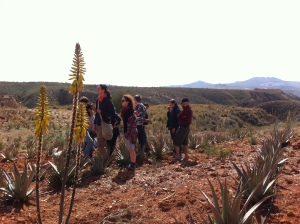
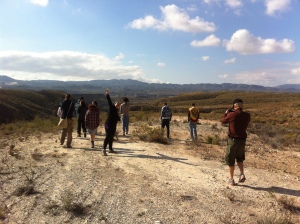
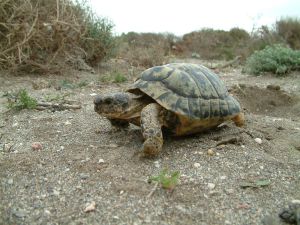
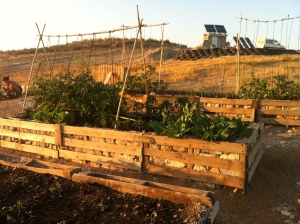

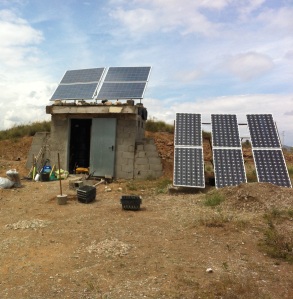
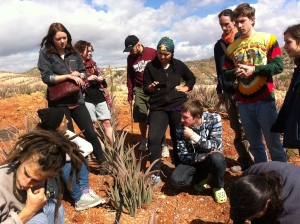 During this visit we even learned how to cut open the leaves and extract the shoots which we then replanted in a zone called “the nursery”, so as to continue the process of regenerating their plantation without the need to buy new plants.
During this visit we even learned how to cut open the leaves and extract the shoots which we then replanted in a zone called “the nursery”, so as to continue the process of regenerating their plantation without the need to buy new plants.
